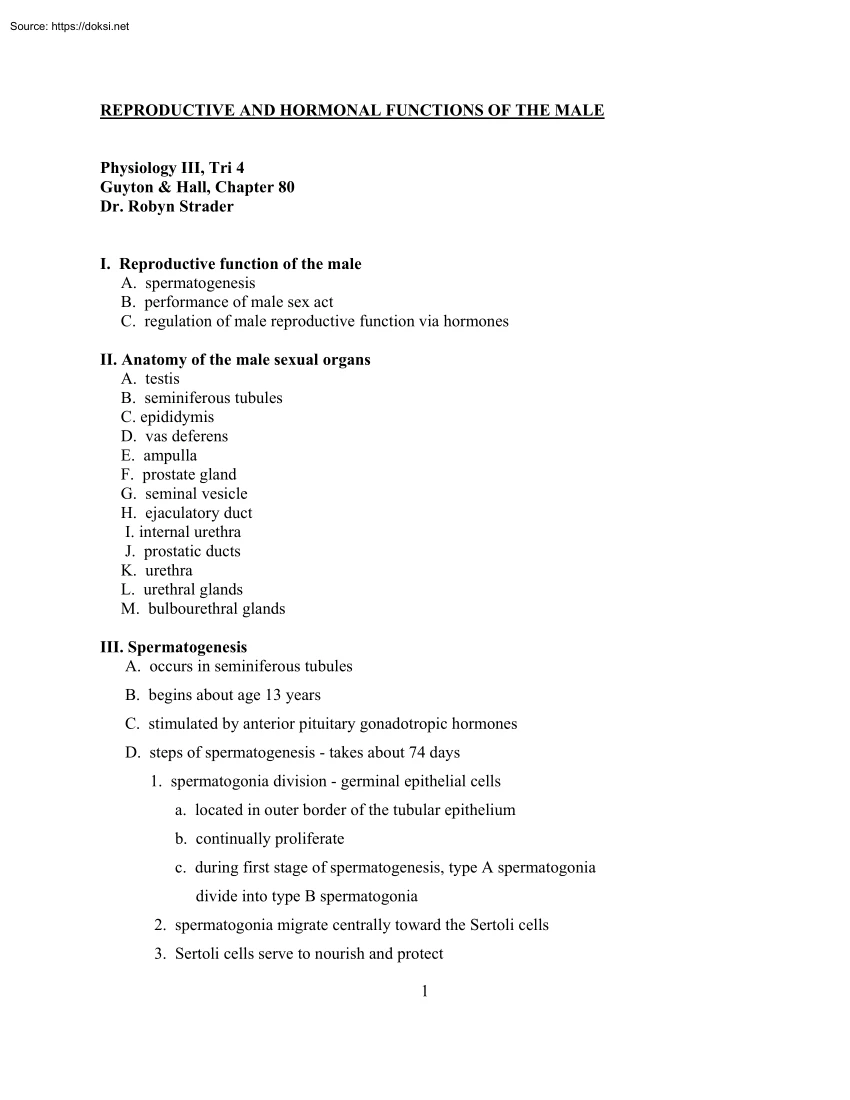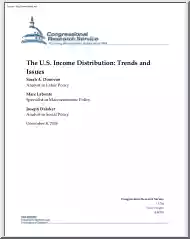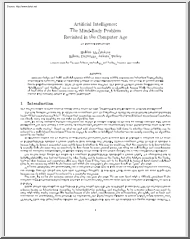A doksi online olvasásához kérlek jelentkezz be!

A doksi online olvasásához kérlek jelentkezz be!
Nincs még értékelés. Legyél Te az első!
Mit olvastak a többiek, ha ezzel végeztek?
Tartalmi kivonat
REPRODUCTIVE AND HORMONAL FUNCTIONS OF THE MALE Physiology III, Tri 4 Guyton & Hall, Chapter 80 Dr. Robyn Strader I. Reproductive function of the male A. spermatogenesis B. performance of male sex act C. regulation of male reproductive function via hormones II. Anatomy of the male sexual organs A. testis B. seminiferous tubules C. epididymis D. vas deferens E. ampulla F. prostate gland G. seminal vesicle H. ejaculatory duct I. internal urethra J. prostatic ducts K. urethra L. urethral glands M. bulbourethral glands III. Spermatogenesis A. occurs in seminiferous tubules B. begins about age 13 years C. stimulated by anterior pituitary gonadotropic hormones D. steps of spermatogenesis - takes about 74 days 1. spermatogonia division - germinal epithelial cells a. located in outer border of the tubular epithelium b. continually proliferate c. during first stage of spermatogenesis, type A spermatogonia divide into type B spermatogonia 2. spermatogonia migrate centrally toward the Sertoli
cells 3. Sertoli cells serve to nourish and protect 1 4. stages of division: a. spermatogonium b. primary spermatocyte c. secondary spermatocyte - 1st miotic division d. spermatid - 2nd meiotic division e. spermatozoon = sperm E. Sperm formation 1. originate as epithelioid cells 2. elongated into spermatozoon with head and tail 3. head contains condensed nucleus, thin cytoplasm, and cell membrane 4. head contains thick cap (acrosome) formed mainly from Golgi apparatus 5. acrosome contains lysosomal enzymes - hyaluronidase, proteolytic enzymes 6. flagellum has three parts: a. axoneme - central skeleton b. thin cell membrane c. mitochondria 7. sperm move at a rate of 1 to 4 mm/min F. Hormones involved in spermatogenesis 1. testosterone Testosterone a. secreted by the Leydig cells b. located in interstitium of testis c. essential for growth and division of the germinal cells AGE 2. luteinizing hormone (LH) a. secreted in the anterior pituitary b. stimulates the Leydig cells to secrete
testosterone 3. follicle-stimulation hormone (FSH) a. secreted in the anterior pituitary b. stimulates Sertoli cells c. stimulates the conversion of spermatid to sperm 4. inhibin a. inhibits FSH 2 b. acts on pituitary c. secreted by Sertoli cells or seminiferous tubules 5. estrogens a. formed from testosterone by the Sertoli cells b. probably essential for spermiogenesis c. testosterone and estrogen carried into seminiferous tubular lumen by androgen-binding protein 6. growth hormone a. controls metabolic functions of testes b. promotes early division of spermatogonia G. Maturation of sperm in the epididymis 1. initially, sperm in the epididymis are nonmotile and infertile 2. after 18-24 hours in epididymis, motility is developed 3. inhibitory proteins in epididymal fluid prevent movement until after ejaculation 4. epididymis epithelium secrete testosterone and estrogens that produce maturation H. Storage of sperm 1. 120 million sperm/day 2. most are stored in vas deferens and
ampulla of the vas deferens, some in epididymis 3. stored sperm remain fertile for about 1 month I. Physiology of sperm 1. flagellated movement through fluid media 2. rate of 1-4 mm/min 3. travel in straight line (normal) 4. activity enhanced by : a. neutral or alkaline media (ejaculated semen) b. increased temperature IV. Seminal Vesicles A. Secretory gland - lined with secretory epithelium B. Secretes mucoid material containing fructose, prostaglandins, fibrinogen, and other 3 nutrient substances C. During emission - seminal vesicle empties its contents into ejaculated semen D. Prostaglandins aid in fertilization: 1. reacts with cervical mucus 2. reversing peristaltic contractions of uterus and fallopian tubes V. Prostate Gland A. Secretes thin, milky, alkaline fluid containing: 1. citrate ion 2. calcium 3. acid phosphate 4. clotting enzyme 5. profibrinolysin B. Contracts simultaneously with contraction of the vas deferens C. Alkaline fluid counteracts acidic fluid of vas
deferens and vaginal secretions D. pH 6 -65 = sperm optimally motile VI. Semen A. Semen = fluid + sperm B. Seminal fluid: 1. 10% vas deferens 2. 60% seminal vesicles 3. 30% prostate gland 4. small amount from mucous glands (bulbourethral) C. Seminal vesicle fluid - washes sperm out of ejaculatory duct and urethra D. Average pH = 75 E. Clotting enzyme of the prostatic fluid causes fibrinogen of the seminal vesicle fluid to form a weak coagulum - holds semen in vagina F. Prostatic profibrinolysin forms fibrinolysin - causing lysis of coagulum within 15 to 30 minutes 4 G. Sperm life span: 1. 24 - 48 hours at body temperature 2. weeks at lowered temperatures 3. years at temperatures below -100 C VII. Capacitation of the Spermatozoa A. Changes that activate the sperm 1. uterine and fallopian tube fluids wash away inhibitory factors 2. cholesterol in sperm acrosome begins to wear away 3. sperm head becomes permeable to calcium ions causing increased activity in the flagellum 4. membrane
around acrosome becomes permeable to Ca ions causing release of enzymes that aid in fertilization B. Acrosome enzymes: 1. hyaluronidase - depolymerizes the hyaluronic acid polymers in the intercellular cement holding the granulosa cells together 2. proteolytic enzymes - digest proteins in the structural elements of the tissues VIII. Abnormal Spermatogenesis and Male Fertility A. Destruction of seminiferous tubular epithelium 1. mumps 2. strictures in the genital ducts 3. genetic abnormalities 4. excessive temperatures B. Cryptorchidism - failure of testis to descend from the abdomen C. Sperm count: 1. normal = 35-200 million/ml, (35 ml/ejaculate) 2. sperm count below 20 million/ml = infertility D. Sperm shape and motility 5 IX. Male Sex Act A. Neuronal stimulus 1. glans penis - most important source of impulses, sensitive sensory end-organ 2. pathway: a. glans penis b. pudendal nerve c. sacral plexus d. sacral portion of the spinal cord e. cerebrum 3. other areas of stimulation:
a. anal epithelium b. scrotum 6 c. perineal structures d. internal structures - urethra, bladder, prostate, seminal vesicles, testes, vas deferens B. Psychic stimulation - ex nocturnal emissions C. Spinal cord - reflex mechanisms in the sacral and lumbar spinal cord D. Stages of the male sexual act 1. erection a. parasympathetic impulses b. dilation of penile arteries c. arterial pressure builds up in erectile tissue of the corpus cavernosum and corpus spongiosum d. increased pressure causes penis to become hard and elongated 2. lubrication a. parasympathetic impulses to urethral glands and bulbourethral glands causes secretion of mucus b. necessary for success of male sex act 3. emission a. sympathetic impulses b. begins with contraction of the vas deferens and ampulla - expels sperm into internal urethra c. contraction of prostate gland d. contraction of seminal vesicles e. prostatic fluid and seminal fluid force sperm forward 4. ejaculation a. filling of the internal
urethra elicits sensory signals b. sensory signals: - give feeling of fullness - excite rhythmic contractions of internal genital organs - contraction of the ischiocavernosus and bulbocavernosus muscles c. contraction of skeletal muscles aid in propelling semen into vagina 7 X. Male Sex Hormones A. Androgens (steroid hormone with masculinizing effects), secreted by the testes 1. testosterone - most abundant, secreted by interstitial cells of Leydig 2. dihydrotestosterone 3. androstenedione B. Leydig cells 1. located in the interstices of the seminiferous tubules 2. secrete testosterone 3. testosterone production seen at birth and after puberty C. Secretion of androgens elsewhere in the body 1. adrenal glands 2. embryonic rest cells (rare, female) D. Chemistry - produced from cholesterol or acetyl coenzyme A E. Metabolism of testosterone 1. most is bound to albumin of a carrier protein 2. circulates in the blood for 30-60 minutes 3. attaches to cell and converts to
dihydrotestosterone and 5-alphaandrostanediol F. Degradation by the liver 1. converted to androsterone and dehydroepiandrosterone 2. conjugated either as glucuronides or sulfates 3. excreted in bile or into urine G. Estrogen production 1. Sertoli cells 2. formed from testosterone XI. Functions of Testosterone A. Masculine characteristics B. Development of male genital C. Descent of the testes 8 D. Body hair - terminal 1. pubic 2. linea alba 3. face 4. other regions E. Baldness 1. genes 2. androgens F. Voice G. Skin H. Acne I. Protein formation J. Bone growth and calcium retention K. BMR L. RBC's M. Electrolyte and water balance 9
cells 3. Sertoli cells serve to nourish and protect 1 4. stages of division: a. spermatogonium b. primary spermatocyte c. secondary spermatocyte - 1st miotic division d. spermatid - 2nd meiotic division e. spermatozoon = sperm E. Sperm formation 1. originate as epithelioid cells 2. elongated into spermatozoon with head and tail 3. head contains condensed nucleus, thin cytoplasm, and cell membrane 4. head contains thick cap (acrosome) formed mainly from Golgi apparatus 5. acrosome contains lysosomal enzymes - hyaluronidase, proteolytic enzymes 6. flagellum has three parts: a. axoneme - central skeleton b. thin cell membrane c. mitochondria 7. sperm move at a rate of 1 to 4 mm/min F. Hormones involved in spermatogenesis 1. testosterone Testosterone a. secreted by the Leydig cells b. located in interstitium of testis c. essential for growth and division of the germinal cells AGE 2. luteinizing hormone (LH) a. secreted in the anterior pituitary b. stimulates the Leydig cells to secrete
testosterone 3. follicle-stimulation hormone (FSH) a. secreted in the anterior pituitary b. stimulates Sertoli cells c. stimulates the conversion of spermatid to sperm 4. inhibin a. inhibits FSH 2 b. acts on pituitary c. secreted by Sertoli cells or seminiferous tubules 5. estrogens a. formed from testosterone by the Sertoli cells b. probably essential for spermiogenesis c. testosterone and estrogen carried into seminiferous tubular lumen by androgen-binding protein 6. growth hormone a. controls metabolic functions of testes b. promotes early division of spermatogonia G. Maturation of sperm in the epididymis 1. initially, sperm in the epididymis are nonmotile and infertile 2. after 18-24 hours in epididymis, motility is developed 3. inhibitory proteins in epididymal fluid prevent movement until after ejaculation 4. epididymis epithelium secrete testosterone and estrogens that produce maturation H. Storage of sperm 1. 120 million sperm/day 2. most are stored in vas deferens and
ampulla of the vas deferens, some in epididymis 3. stored sperm remain fertile for about 1 month I. Physiology of sperm 1. flagellated movement through fluid media 2. rate of 1-4 mm/min 3. travel in straight line (normal) 4. activity enhanced by : a. neutral or alkaline media (ejaculated semen) b. increased temperature IV. Seminal Vesicles A. Secretory gland - lined with secretory epithelium B. Secretes mucoid material containing fructose, prostaglandins, fibrinogen, and other 3 nutrient substances C. During emission - seminal vesicle empties its contents into ejaculated semen D. Prostaglandins aid in fertilization: 1. reacts with cervical mucus 2. reversing peristaltic contractions of uterus and fallopian tubes V. Prostate Gland A. Secretes thin, milky, alkaline fluid containing: 1. citrate ion 2. calcium 3. acid phosphate 4. clotting enzyme 5. profibrinolysin B. Contracts simultaneously with contraction of the vas deferens C. Alkaline fluid counteracts acidic fluid of vas
deferens and vaginal secretions D. pH 6 -65 = sperm optimally motile VI. Semen A. Semen = fluid + sperm B. Seminal fluid: 1. 10% vas deferens 2. 60% seminal vesicles 3. 30% prostate gland 4. small amount from mucous glands (bulbourethral) C. Seminal vesicle fluid - washes sperm out of ejaculatory duct and urethra D. Average pH = 75 E. Clotting enzyme of the prostatic fluid causes fibrinogen of the seminal vesicle fluid to form a weak coagulum - holds semen in vagina F. Prostatic profibrinolysin forms fibrinolysin - causing lysis of coagulum within 15 to 30 minutes 4 G. Sperm life span: 1. 24 - 48 hours at body temperature 2. weeks at lowered temperatures 3. years at temperatures below -100 C VII. Capacitation of the Spermatozoa A. Changes that activate the sperm 1. uterine and fallopian tube fluids wash away inhibitory factors 2. cholesterol in sperm acrosome begins to wear away 3. sperm head becomes permeable to calcium ions causing increased activity in the flagellum 4. membrane
around acrosome becomes permeable to Ca ions causing release of enzymes that aid in fertilization B. Acrosome enzymes: 1. hyaluronidase - depolymerizes the hyaluronic acid polymers in the intercellular cement holding the granulosa cells together 2. proteolytic enzymes - digest proteins in the structural elements of the tissues VIII. Abnormal Spermatogenesis and Male Fertility A. Destruction of seminiferous tubular epithelium 1. mumps 2. strictures in the genital ducts 3. genetic abnormalities 4. excessive temperatures B. Cryptorchidism - failure of testis to descend from the abdomen C. Sperm count: 1. normal = 35-200 million/ml, (35 ml/ejaculate) 2. sperm count below 20 million/ml = infertility D. Sperm shape and motility 5 IX. Male Sex Act A. Neuronal stimulus 1. glans penis - most important source of impulses, sensitive sensory end-organ 2. pathway: a. glans penis b. pudendal nerve c. sacral plexus d. sacral portion of the spinal cord e. cerebrum 3. other areas of stimulation:
a. anal epithelium b. scrotum 6 c. perineal structures d. internal structures - urethra, bladder, prostate, seminal vesicles, testes, vas deferens B. Psychic stimulation - ex nocturnal emissions C. Spinal cord - reflex mechanisms in the sacral and lumbar spinal cord D. Stages of the male sexual act 1. erection a. parasympathetic impulses b. dilation of penile arteries c. arterial pressure builds up in erectile tissue of the corpus cavernosum and corpus spongiosum d. increased pressure causes penis to become hard and elongated 2. lubrication a. parasympathetic impulses to urethral glands and bulbourethral glands causes secretion of mucus b. necessary for success of male sex act 3. emission a. sympathetic impulses b. begins with contraction of the vas deferens and ampulla - expels sperm into internal urethra c. contraction of prostate gland d. contraction of seminal vesicles e. prostatic fluid and seminal fluid force sperm forward 4. ejaculation a. filling of the internal
urethra elicits sensory signals b. sensory signals: - give feeling of fullness - excite rhythmic contractions of internal genital organs - contraction of the ischiocavernosus and bulbocavernosus muscles c. contraction of skeletal muscles aid in propelling semen into vagina 7 X. Male Sex Hormones A. Androgens (steroid hormone with masculinizing effects), secreted by the testes 1. testosterone - most abundant, secreted by interstitial cells of Leydig 2. dihydrotestosterone 3. androstenedione B. Leydig cells 1. located in the interstices of the seminiferous tubules 2. secrete testosterone 3. testosterone production seen at birth and after puberty C. Secretion of androgens elsewhere in the body 1. adrenal glands 2. embryonic rest cells (rare, female) D. Chemistry - produced from cholesterol or acetyl coenzyme A E. Metabolism of testosterone 1. most is bound to albumin of a carrier protein 2. circulates in the blood for 30-60 minutes 3. attaches to cell and converts to
dihydrotestosterone and 5-alphaandrostanediol F. Degradation by the liver 1. converted to androsterone and dehydroepiandrosterone 2. conjugated either as glucuronides or sulfates 3. excreted in bile or into urine G. Estrogen production 1. Sertoli cells 2. formed from testosterone XI. Functions of Testosterone A. Masculine characteristics B. Development of male genital C. Descent of the testes 8 D. Body hair - terminal 1. pubic 2. linea alba 3. face 4. other regions E. Baldness 1. genes 2. androgens F. Voice G. Skin H. Acne I. Protein formation J. Bone growth and calcium retention K. BMR L. RBC's M. Electrolyte and water balance 9



